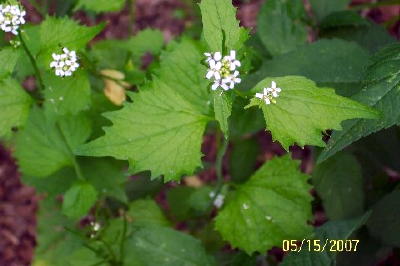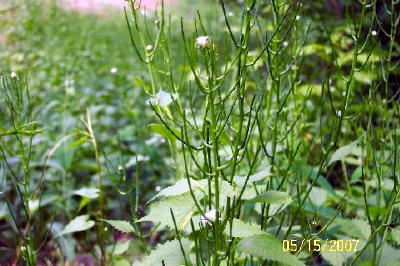GARLIC MUSTARD NEWEST ALIEN INVADER - Making Debut In Calhoun And Regional Counties

By Russ Richardson
Garlic mustard is the newest alien invader to attack local forests.
Garlic mustard (Alliaria petiolata), is a biennial herbaceous plant that flowers and goes to seed in early spring and is a rapidly spreading problem in the central and northern part of West Virginia.
It has recently begun to show up in Calhoun and Roane Counties.
Garlic mustard presents a very serious threat to the survival of our native hardwood forests that could potentially be more damaging than Japanese stiltgrass.
Garlic mustard roots put out chemicals that change the soil and have now been proven to kill soil organisms responsible for the germination of yellow poplar, sugar and red maple, white ash seedlings.
Unlike invasive plants such as Japanese stiltgrass, kudzu or multifloral rose that move into and become established in disturbed areas like pastures, gullies and roadsides, garlic mustard readily spreads into high quality forests where no soil disturbance has taken place.

Garlic mustard seed is extremely small. A single plant can produce nearly 10,000 seeds and with over 250,000 seeds per pound.
In addition to causing long term damage to soil fertility and woodland productivity, garlic mustard produces seed that will stay viable in the soil for years as a "seed bank".
Seeds produced in 2008 will continue to germinate for at least ten years.
In most areas where the soil is infested with garlic mustard, important woodland plants like ginseng, Goldenseal, ramps and black Cohosh will disappear and never return. Land with garlic mustard present on the forest floor prior to logging has a good likelihood of never producing another hardwood forest again without planting.
In Wisconsin there is concern and research is underway to determine whether garlic mustard will also kill morel mushrooms.
The only way to control garlic mustard is to prevent the maturing of the plants and dispersal of the seeds during the early spring growing season. Hand pulling, severe weed whacker treatment or herbicide spraying with a product like Roundup is effective.
Because the plant is so visible during its flowering stage hand pulling garlic mustard plants is recognized as one of the most effective control methods, especially when an invasion is in its early stages.
However, of all the possible options available the most effective treatment program in the fight against garlic mustard is to prevent it from becoming established on your property.
 For more information on garlic mustard see invasivespeciesinfo.gov